|
A healthy agriculture can only take place within nature and in co-operation with its processes, not in spite of it and not by ‘conquering’ it.
– Wendell Berry, from A Continuous Harmony
Successful gardening depends on utilizing what nature has provided. While there are basic tenets that hold regardless of the environment in which you’re gardening, certain approaches and techniques are unique to different environments. What it takes to garden successfully in Seattle differs from Boston, which differs from Tucson. If you’re familiar with gardening in humid climates, you will quickly discover `that many of those practices no longer work well in the desert.
Please see our online catalog to order gardening books.
Go local
Among the first things one should consider when gardening is to look for local sources of information – and seeds. Since NS/S is based in the Sonoran Desert, our gardening tips are geared to the Tucson area.
In order to produce healthy seed, you must start with healthy seed. Only plant healthy, non-diseased seed or transplants. There are many sources for organic, open-pollinated or heirloom seeds on the market today, starting with the largest assortment of aridlands-adapted varieties at NS/S (make a link to the Seed Listing section on our website). Our partners page has list of seed source resources.
Soils
Garden soil is the foundation of good gardening. Healthy soil teams with thousands of micro-organisms that break down decaying organic matter and provide nutrients to growing plants. Overall, there are thousands of different types of soil, but aridisols are the primary soil type found in deserts around the world and in the Tucson area specifically. Aridisols are alkaline, light-colored and low in organic matter. Already alkaline by nature, aridisols are treated differently than soils in more humid climates, where lime and wood ash are often used to increase soil alkalinity (raise soil pH). In the desert, gardeners must lower soil pH, primarily through the addition of compost and manure. Addition of organic matter also provides nutrients and improves soil structure and water holding capacity. Unfortunately, some gardeners in the Tucson area will have to deal with caliche (calcium carbonate that often forms a cement-like impenetrable layer that must be broken up or removed before planting).
|
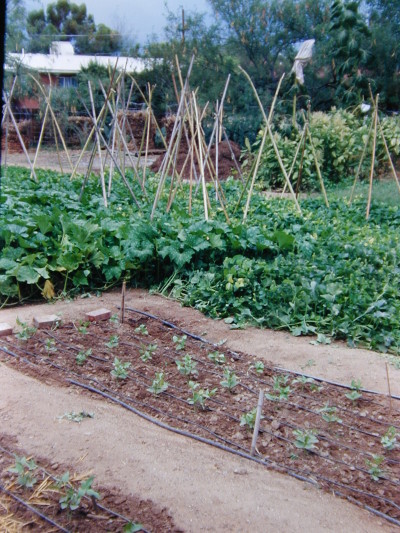
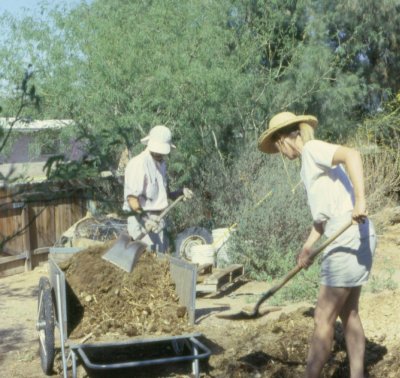
|
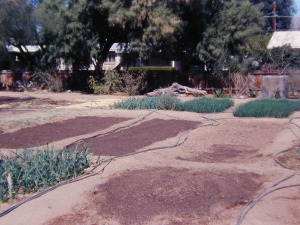 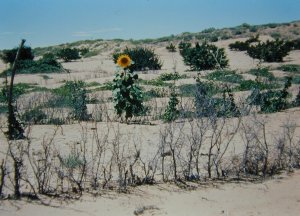
Sunken beds at the NS/S Seed Bank(left) and ‘Waffle beds’ planted with beans at Hopi (right).
Spacing
Plants compete with each other for light, water and soil nutrients. Use recommended spacings when planting, both within and between rows. Don’t hesitate to thin plants that have been over-seeded or are too close to each other. Plants often compensate for less space by growing smaller, producing fewer fruits or even smaller seeds. More plants in an area doesn’t necessarily translate into more yield. Don’t skimp on the space required to produce healthy, abundant seeds. Additionally, good air circulation between plants can help reduce insect and disease problems.
Recommended plant spacings for desert crops (within a row)
4-6 inches: Bean, Garbanzo, Garlic, Lentils, Onions (shallot-like), Peas, Wheat
6-12 inches: Amaranth, Basil, Black-eyed peas, Chiles, Corn, Herbs, Mustard greens, Tobacco, Tomatillo, Tomato
12-18 or more inches: Cotton, Devil’s Claw, Gourd, Melon, Okra, Squash/Pumpkin, Sunflower, Watermelon
Planting
New gardeners often worry about how deep to sow seeds. For very small-seeded crops, such as carrot, seeds are only covered by 1/4 inch or so of soil. Larger seeds can be planted up to a few inches (2-4 inches). The main trick is to ensure that soil in which seeds are planted remains moist, but not waterlogged, until the seeds germinate.
Watering
Perhaps the most difficult task for those new to desert gardening is watering. Forget what you learned in more humid climates, it won’t help much in the desert. Desert soils around Tucson tend to dry out somewhat quickly and can become hard as rock on the surface, making it difficult for young emerging seedlings to break through. Mulching helps keep soil surfaces moist for germination. A light spray of water on the surface is all that’s needed, as no more than the top 2-4 inches of soil needs to be moist for germinating seeds. Once seedlings emerge, however, deep watering will be necessary.
A common mistake among gardeners new to the desert is to water often and shallowly. Deep watering encourages vigorous deep root growth early in the season, which helps discourage water stress later in the season. Deep watering is accomplished by slowly flooding an area and allowing it to soak deeply into the soil profile. This also helps to flush out salts and prevent salt buildup. There is no standard guide to how often watering should be done in desert gardening. The best method is to simply watch the plant. Water stress is typically detected by leaf wilting. Some wilting is common during the day, even in well-watered plants. If plants do not recover overnight from day-time wilting, then they are likely in need of water.
A common misunderstanding is that ‘drought-adapted’ or ‘aridlands’ crops don’t need much water, as evidenced by the fact that they grow in drought-prone or arid areas. Even within these areas, most crops are grown during the rainy season, however scarce it may prove to be in any given year. ‘Drought-adapted’ or ‘drought-tolerant’ doesn’t mean a crop prefers to grow under drought conditions. Rather, it means a crop might survive some drought conditions where other, more conventional crops might not. Don’t be fooled, plants require sufficient water, nutrients and light to produce healthy seeds, regardless of whether they are considered ‘drought-tolerant’ or not. Some plants, such as tepary bean and black-eyed peas, are not tolerant of soggy soils. When their roots are submerged in standing water for days on end, their leaves often turn yellow and drop, a symptom that also occurs under conditions of insufficient water!
 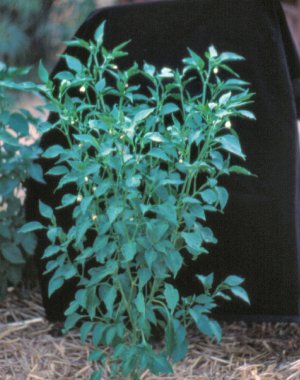
A chile plant under severe water stress (left) and when well-watered (right).
|
|
Fertilizing
Plants need nutrients. Addition of compost and well-aged manures, as well as green manures and cover crops, are good ways of maintaining soil nutrient levels and adding organic matter, which continues to break down slowly over time. These are best added before planting. Mid-season fertilizers are easily accomplished with fish emulsions or manure or compost teas. Not all plants have the same fertilizer requirements, so check before you apply broadly.
Mulching
Mulching is a necesssity for desert gardeners as it greatly reduces evaporation and keeps soil temperatures lower. Spread straw, hay (may contain more weed seeds than straw), leaves, or other oganic matter as a layer about 3 inches thick over beds. Replenish during the season as needed. Seasonal weeds can also be used for mulch as long as they are pulled before producing seeds.
|

|







